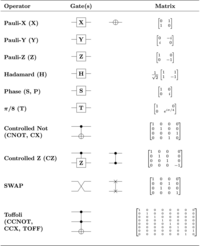Quantum logic gate

Alright kid, imagine you have two light switches in your room. One switch controls the light bulb on your left side and the other switch controls the light bulb on your right side. Now, if you turn on the left switch, the left light bulb lights up and if you turn on the right switch, the right light bulb lights up.
Similarly, in the world of quantum computing, we have something called quantum logic gates. These gates are like switches that control the behavior of quantum bits, also known as qubits. Qubits are tiny particles that can exist in multiple states at the same time, which is different from classical bits used in regular computers that can only have two states, either 0 or 1.
So, a quantum logic gate is like a switch that can turn on or off the qubits in specific ways that change their state. These switches can be used together to perform computations, just like how we use multiple light switches to control the lights in our room.
Now, there are different types of quantum logic gates, each with their own specific function. For example, the Hadamard gate can put a qubit in a superposition state, which means it can exist in multiple states at the same time. The CNOT gate, on the other hand, can control the interaction and entanglement between two qubits.
These gates are very important in quantum computing because they are used to perform complex calculations that would take centuries to solve with traditional computers. And that kid, is the basic idea behind quantum logic gates.
Similarly, in the world of quantum computing, we have something called quantum logic gates. These gates are like switches that control the behavior of quantum bits, also known as qubits. Qubits are tiny particles that can exist in multiple states at the same time, which is different from classical bits used in regular computers that can only have two states, either 0 or 1.
So, a quantum logic gate is like a switch that can turn on or off the qubits in specific ways that change their state. These switches can be used together to perform computations, just like how we use multiple light switches to control the lights in our room.
Now, there are different types of quantum logic gates, each with their own specific function. For example, the Hadamard gate can put a qubit in a superposition state, which means it can exist in multiple states at the same time. The CNOT gate, on the other hand, can control the interaction and entanglement between two qubits.
These gates are very important in quantum computing because they are used to perform complex calculations that would take centuries to solve with traditional computers. And that kid, is the basic idea behind quantum logic gates.
Related topics others have asked about:
